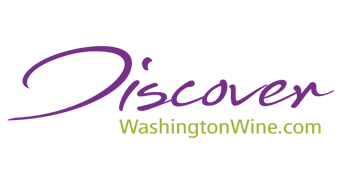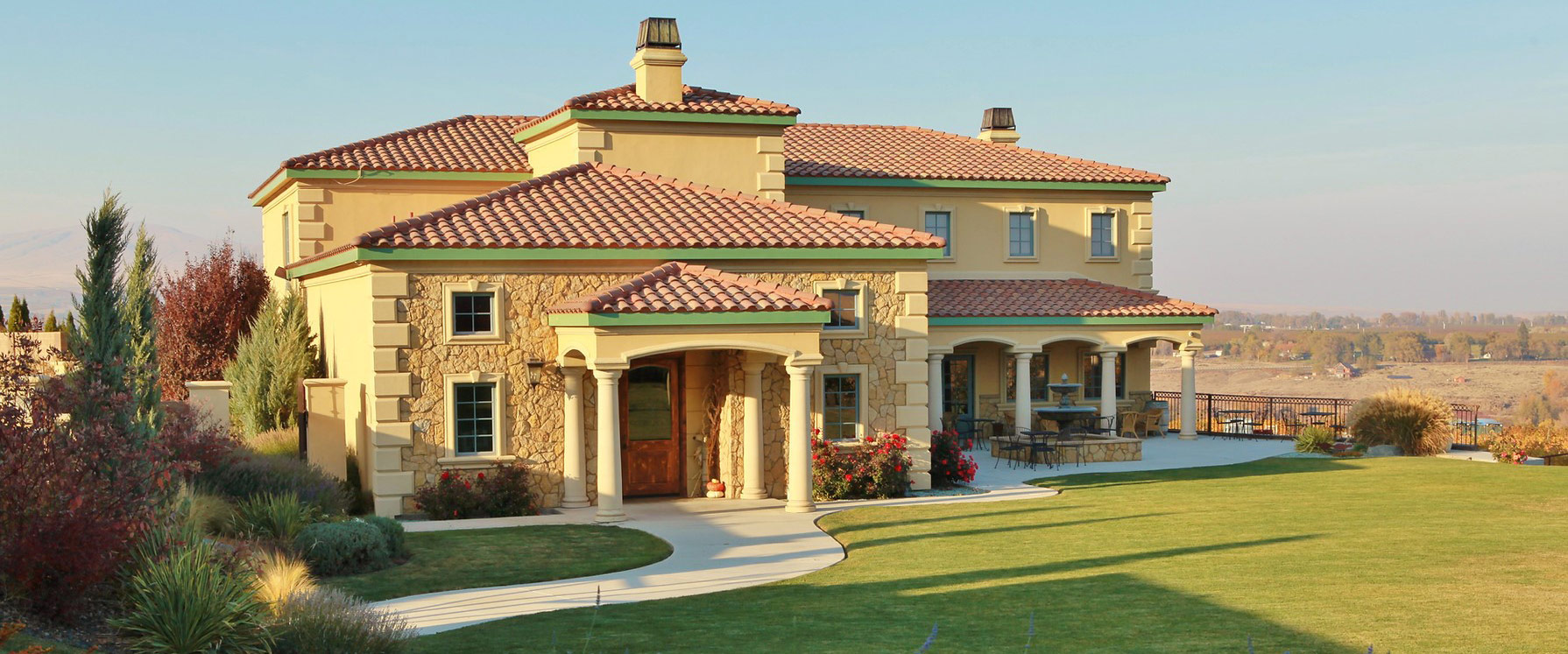Len Parris, Owner of Chandler Reach Vineyard, Admits That
He Had a Lot to Learn When He Planted His First Wine Grapes
But 24 years later, Parris has a thriving winery making multiple varieties of wines, a villa that looks like
it was transported from Italy’s Tuscan grape growing region, and a satellite tasting room in Woodinville, WA.
By Ken Robertson
Len Parris can give you a long list of things he didn’t know when he started planting the first wine grapes in what would become known as Chandler Reach Vineyard in 1999 near a little-known exit off Interstate 82 in Southeastern Washington labeled “Yakitat.”
He didn’t know that the 42.7-acre site just 15 miles west of Richland, WA., had its own microclimate. He didn’t know there was a spot above the area where warm winds off the Pacific Ocean would spill over the Horse Heaven Hills near Alderdale.
And he didn’t know that when those winds swept downhill toward the Yakima River, they would warm even further as they gained downhill momentum and slipped down into the Yakima River Valley.
Soon enough, Parris discovered he also had a lot to learn about how to plant and nurture a vineyard, keep it healthy, properly pruned and trimmed so that grape yields would stay in proportion to what his plants could support, nurture and ripen. His learning curve, he readily admits, “was straight up.”
Luckily, the land, its climate, its “terroir” as the French call it, his neighbors, friends and even some passersby who stopped to see what he was up to all offered encouragement.
Decades later, he still marvels at his luck that a couple of about-to-be famous Washington winemakers stopped by and offered their observations, once the vines were up and showing off their growth to those driving past on nearby I-82.
First, John Abbott of Walla Walla’s Abeja Winery, stopped to look at the fledgling planting. When Parris fretted that his north-facing site might not be right for wine grapes, Abbott observed that it might instead turn out to be “a blessing” when the summer’s heat settled in over Red Mountain and regularly surpassed 100 degrees.
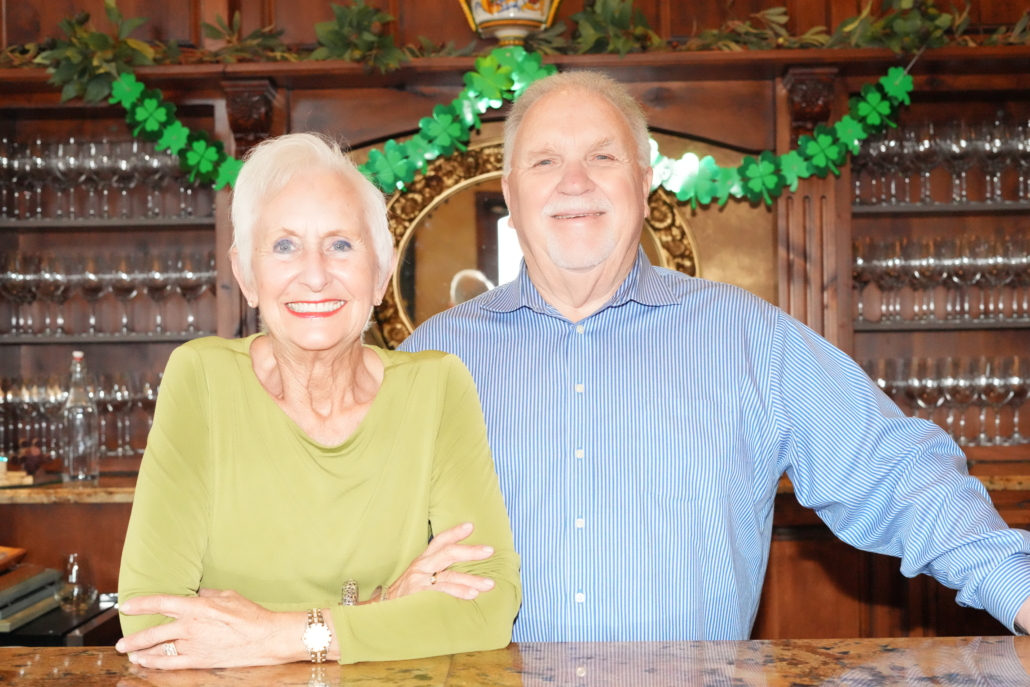
Len Parris and his wife Jane celebrated their 42nd wedding anniversary on St. Patrick’s Day 2023 at — where else — the Villa at Chandler Reach Winery. It’s a good bet that wine was served at the party.
Not long after, Brian Carter, now famous across the Northwest for his exceptional skill at creating red blends, also stopped to take a look. Again, as Parris recalls, Carter also suggested that the north-facing site “probably would be a gift in those hot years.”
Encouraged, Parris continued, along the way talking repeatedly with his classmate from Richland High School (Columbia High back then), Tom Hedges, who with his wife Anne-Marie founded Hedges Family Estate on nearby Red Mountain in 1987. Among the pioneer grape growers and winemakers on what’s become one of the Northwest’s top AVAs, Hedges was both encouraging and a great resource, Parris said.
His Yakitat vineyard site, which sounds like it ought to be from a Native American tribe’s language, can claim that origin — sort of. It’s a combination of Yakima and Klickitat, ginned up by a Seattle land promoter, Augustus “Gus” Smith, who was hoping to sell chunks of the rocky, arid site to gullible folks seeking a homesite in the West. Part of a land and irrigation development surge that began in the late 1800s, Yakitat originally was platted on 500 acres into 5,300 lots, but never came to be, according to Benton County historian Jean Carol Davis and Vickie Silliman Bergum, a former director of the East Benton County Museum in Kennewick, WA., who collaborated on a 1997 book of Benton County Place names.
Though Smith apparently sold many of those lots, they turned out to be worth less than the 90-cent filing fee to record the deeds. Land in that area ultimately turned out to be a great site for Parris — not only to plant wine grapes but also to build his dream Italian-style manor, a concept he and friends had envisioned during a trip to Northern Italy several years before he and his Dad acquired the land.
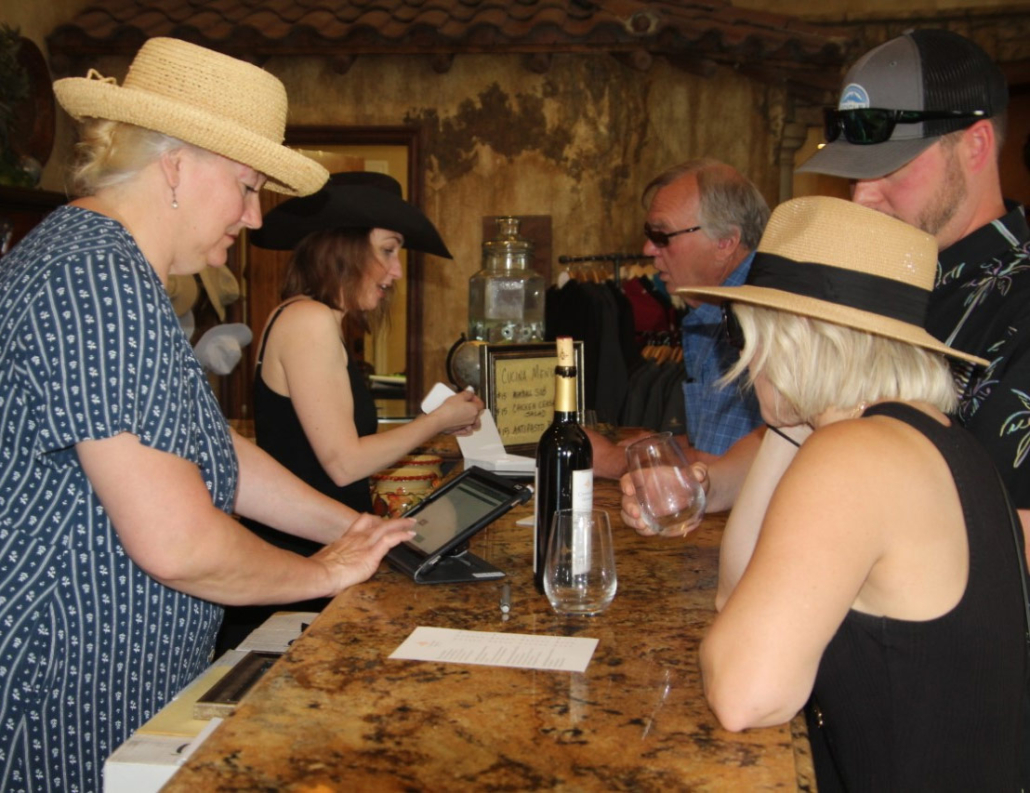
Carolyn Knee, Estate Winery Manager (left) and Meghan Parris, General Manager (standing next to Carolyn) were busy all day serving guests during Chandler Reach’s Spring Barrel Wine Tasting Event on Saturday, April 29. Photo by Ivory Leininger.
Like most of the lower Yakima Valley and Red Mountain, the site had been flooded repeatedly during the Ice Age floods spawned by melting ice dams that held back Lake Missoula, a body of water that was about the size of all five of the Great Lakes combined. As those floods spread west, racing at speeds sometimes exceeding 60 mph, they flooded the Yakima Valley with up to 900 feet of water.
As the waters eddied around Red Mountain and flushed into the gullies of the Horse Heaven Hills, high-calcium floodwaters slowed, dumped chunks of rock and soil ranging as large as a Buick, a new base layer of soil was left behind. Ever since, the prevailing winds from the southwest have sifted fine soils over the tops of the Horse Heavens, sifting the valley below the Horse Heavens with fresh soil deposits.
Left behind when the floods ended about 10,000 years ago were thin, rocky soils interspersed with dried-up lakebeds of silt and rocky basalt cliffs and outcrops.
As irrigation projects developed over the past 150 years on what once had been desert, farmers eventually discovered hundreds of crops could be grown in the Columbia and Yakima Valleys. On some of the worst sites for many crops, it turned out wine grape vines, facing the stresses of heat, marginal soils and wind, put their energy into producing thick-skinned fruit and seeds, vital components for great wines.
On the site of Chandler Reach’s vineyard, Parris also discovered that, although it was north-facing, those warm spring winds sweeping down the Horse Heavens tended to bring bud break to his vines earlier than even the notoriously hot Red Mountain.
Parris discovered the site’s benefits when he harvested his first full crop of grapes in 2003. He had planned simply to sell his grapes and let someone else make and sell the wine. But the vineyard and those grapes had reached out to him in an unexpected way, as he described it in a video on the Chandler Reach website:
“I didn’t understand how emotionally involved I’d get. … You start to feel a real connection to the vineyard,” he explained.
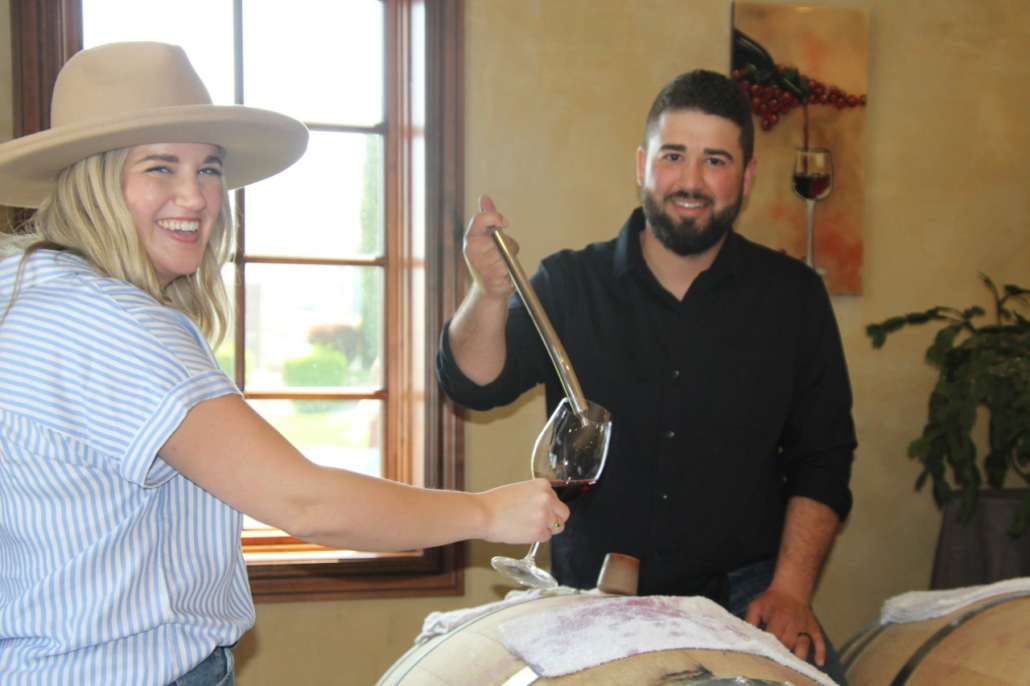
Cole Scott, winemaker at Chandler Reach, had the pleasure of giving his wife Brianne a sample of the winery’s 2021 Cabernet Sauvignon Reserve straight from the barrel during the winery’s Spring Barrel tasting event on Saturday, April 29. Photo by Ivory Leininger.
That connection prompted him to recruit a reluctant Prosser winemaker to make wines from those first grapes. The next day when Parris and he talked again, the winemaker told him: “These numbers are perfect — the pH and TA (total acidity).”
By the time the wines were ready for sale in 2005, Parris had his tasting room ready to open inside an Italian-inspired villa just off the Yakitat exit from Interstate 82 between Prosser and Benton City. The building took its inspiration from a design he originally sketched out on the back of United Airlines paper placemats on a flight home from Italy.
Eventually, he planted an array of wine grapes — Cabernet Sauvignon, Cabernet Franc, Merlot, Carménère, Sangiovese, Barbera, Syrah — on his 42 acres.
They produce his estate and reserve wines, which get the Parris label. He also buys some Malbec from vineyards on Red Mountain and usually has a couple of rosés — one dry, one sweet — and a white wine for sale. Total production is about 3,000 cases annually, sold through the Benton City winery and a satellite tasting room that opened in 2014 in Woodinville’s Hollywood District.
In August of 2022, Parris hired a young man by the name of Cole Scott to handle the winemaking duties at Chandler Reach. Scott spent the previous 11 years at almost every job a winery has to offer. He started out as something of a cellar rat at Goose Ridge Winery in nearby Richland in 2012 where he found he liked the work and ended up at Washington State University’s Tri-Cities campus working on a degree in oenology and viticulture, which he aims to wrap up in 2024 after completing the final class he needs to graduate.
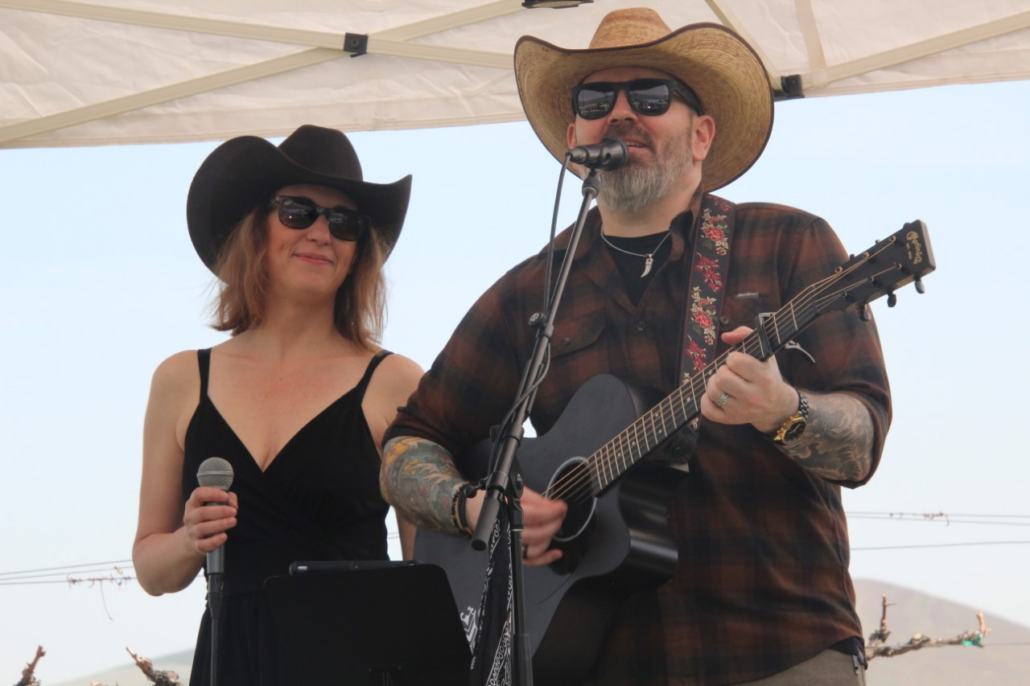
Meghan Parris, daughter of Len and Jane Parris, is a woman of many talents. She is not only the General Manager of Chandler Reach Winery but took the stage with boyfriend Kelly Shirey to entertain guests at the winery’s Spring Barrel Tasting Event on Saturday, April 29. Kelly performs at winery events all over the state of Washington. Check out his website at: www.kellyshirey.com. Photo by Ivory Leininger
Since Parris hired him in August of 2022, Scott has jumped into the top job in the cellar that he’s discovered makes big wines because the winery’s 42 acres of vineyards produce “great fruit,“ especially Sangiovese, Cabernet Franc, Syrah and Cabernet Sauvignon.
Scott bases his judgement on the winery’s newly released 2019 wines, noting that the 2019 Signature Series Cabernet Sauvignon struck gold at the 2023 Seattle Wine Awards and was rated 93 points. Close behind was the 2019 Signature Series Sangiovese, which also won a gold medal and a rating of 92 points.
After years of mostly working in winery labs, which are busiest in the fall when the freshly harvested grapes are coming in to be crushed and then analyzed before and during fermentation, Scott says he’s now busy year-round, always chasing the detail to make the best wine he can.
Over the years, Parris has built a label that has gained a reputation for high quality red varietals and red blends. The blends currently available include:
— Bordeaux-styled “Monte Regalo,” which roughly translates as mountain’s gift in Italian. It’s 55% Cabernet Sauvignon, 20% Merlot, 15% Cabernet Franc, 5% Malbec and 5% Carménère.
— Brevettata, the Italian word for patented or proprietary, a blend of 53% Syrah, 25% Merlot and 22% Sangiovese.
— Villa Rosso, a Tuscan-style red made from 55% Sangiovese Piccolo, 31% Cabernet Sauvignon, 7% Merlot, 4% Sangiovese Grosso and 3% Barbera.
The varietals currently available include Barbera, Cabernet Sauvignon, Malbec and Merlot.
The blends and the Merlot all sell for $35 a bottle, the Barbera and Malbec for $45 and the Cabernet Sauvignon for $55.
And if you prowl the wine aisles at what Parris jokingly calls “that little grocery store” known as Costco, you may find one more wine, known as 36 Red with a label that shows the winery’s vintage truck, a 1936 red Ford flatbed truck with big headlights, a chrome grille and curvy front fenders. It’s an inexpensive red blend you might find for as little as $10 described by some who’ve reviewed it as “a great pizza-night wine.”
No matter which wine draws you to visit Chandler Reach, Parris promises a warm welcome. “We try to treat everybody as family.”
In these post-COVID days, it’s always a good idea to call or email ahead if you’re planning a winery or tasting room visit. And if you’ll be in a group of six or more, it’s a necessary courtesy to ensure you’ll have the best possible experience.
Chandler Reach Estate Vineyard and Winery is located at 9506 W. Chandler Road, Benton City, WA. 99320. Phone: (509) 588-8800. www.chandlerreach.com. Estate Winery Manager: Carolyn J. Knee. The winery’s tasting room in Woodinville is located at 14450 Woodinville-Redmond Road N.E. Woodinville, WA 98072. Phone: (425) 425-892-9999. General Manager: Meghan Parris.
If you aren’t able to get to Chandler Reach’s flagship winery in Benton City, or its satellite tasting room in Woodinville this summer, you can purchase all of the winery’s current releases from its online store by visiting: chandlerreach.orderport.net/wine/Current -Releases.
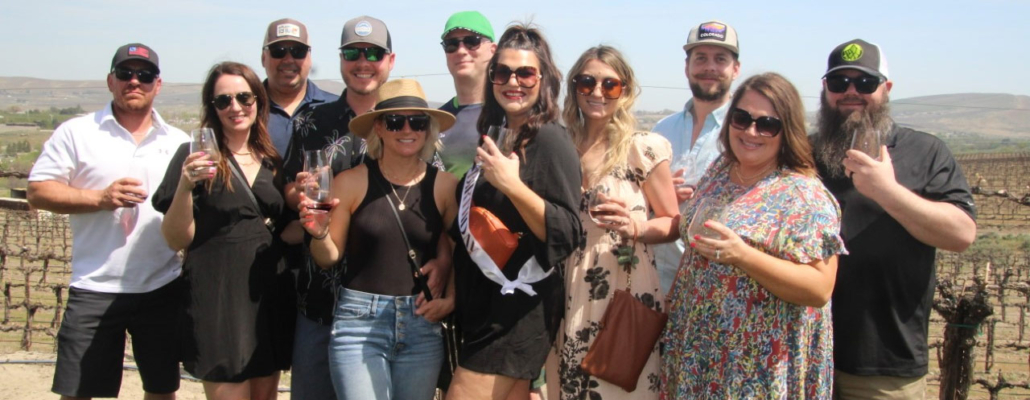
Beth Jones of Kennewick, WA.(wearing special Birthday Ribbon) chose Chandler Reach Winery as the place to celebrate her birthday with 10 of her friends during the winery’s Spring Barrel Tasting event on Saturday, April 29. Photo by Ivory Leininger.
You’ll also want to consider joining the winery’s wine club. Members enjoy popular varietals only available in the tasting rooms, limited-production releases created exclusively for members, as well as special offers and a wide variety of virtual and on-site winery events.
Perks of joining Chandler Reach’s wine club also include: access to limited-production wines made exclusively for club members, invitations to a variety of virtual and on-site winery events, including blending classes, library and vertical tastings, winemaker dinners, harvest celebrations, barrel tasting events and more.
To learn more about joining Chandler Reach’s wine club, visit: www.chandlerreach.com/wine-club. Or call Carolyn Knee at (509) 588-8800.
EDITOR’S NOTE: Ken Robertson has been tasting and writing about Northwest wines since 1978. He retired in 2011 as executive editor of the Tri-City Herald after 43 years working as a newspaper reporter and editor.
